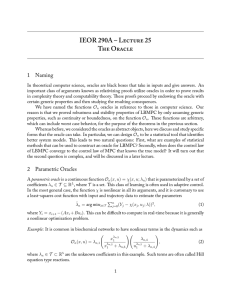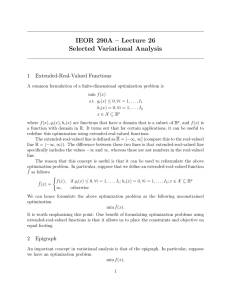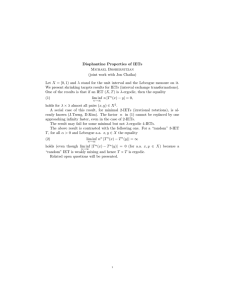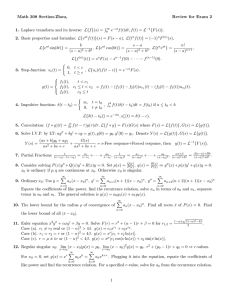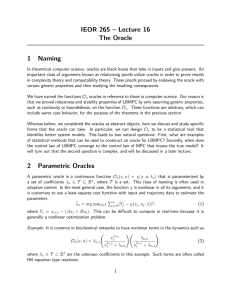IEOR 265 – Lecture 17 The Oracle 1 Naming
advertisement
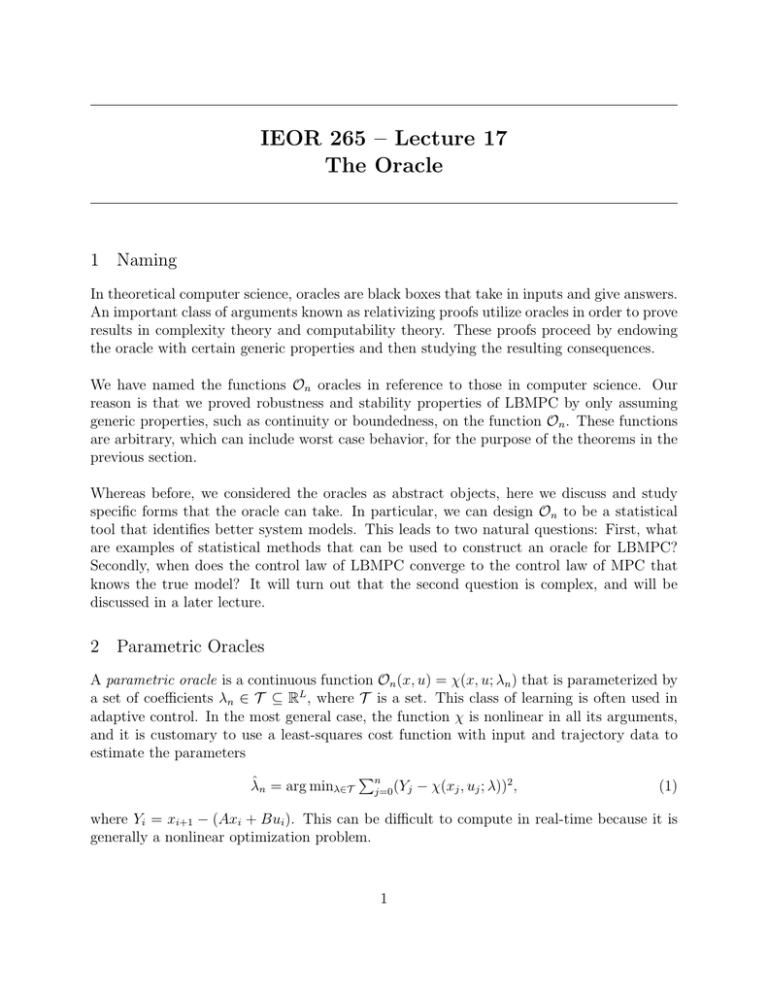
IEOR 265 – Lecture 17
The Oracle
1 Naming
In theoretical computer science, oracles are black boxes that take in inputs and give answers.
An important class of arguments known as relativizing proofs utilize oracles in order to prove
results in complexity theory and computability theory. These proofs proceed by endowing
the oracle with certain generic properties and then studying the resulting consequences.
We have named the functions On oracles in reference to those in computer science. Our
reason is that we proved robustness and stability properties of LBMPC by only assuming
generic properties, such as continuity or boundedness, on the function On . These functions
are arbitrary, which can include worst case behavior, for the purpose of the theorems in the
previous section.
Whereas before, we considered the oracles as abstract objects, here we discuss and study
specific forms that the oracle can take. In particular, we can design On to be a statistical
tool that identifies better system models. This leads to two natural questions: First, what
are examples of statistical methods that can be used to construct an oracle for LBMPC?
Secondly, when does the control law of LBMPC converge to the control law of MPC that
knows the true model? It will turn out that the second question is complex, and will be
discussed in a later lecture.
2 Parametric Oracles
A parametric oracle is a continuous function On (x, u) = χ(x, u; λn ) that is parameterized by
a set of coefficients λn ∈ T ⊆ RL , where T is a set. This class of learning is often used in
adaptive control. In the most general case, the function χ is nonlinear in all its arguments,
and it is customary to use a least-squares cost function with input and trajectory data to
estimate the parameters
∑
(1)
λ̂n = arg minλ∈T nj=0 (Yj − χ(xj , uj ; λ))2 ,
where Yi = xi+1 − (Axi + Bui ). This can be difficult to compute in real-time because it is
generally a nonlinear optimization problem.
1
Example: It is common in biochemical networks to have nonlinear terms in the dynamics
such as
(
)(
)
λn,2
x
λn,4
On (x, u) = λn,1 λn,2 1
,
(2)
λn,5
x1 + λn,3
u1 + λn,4
where λn ∈ T ⊂ R5 are the unknown coefficients in this example. Such terms are often
called Hill equation type reactions.
2.1
Linear Oracles
An important
are those that are linear in the coefficients:
∑Lsubclass of parametric oracles
p
On (x, u) = i=1 λn,i χi (x, u), where χi ∈ R for i = 1, . . . , L are a set of (possibly nonlinear)
functions. The reason for the importance of this subclass is that the least-squares procedure
(1) is convex in this situation, even when the functions χi are nonlinear. This greatly simplifies the computation required to solve the least-squares problem (1) that gives the unknown
coefficients λn .
Example: One special case of linear parametric oracles is when the χi are linear functions.
Here, the oracle can be written as Om (x, u) = Fλm x + Gλm u, where Fλm , Gλm are matrices
whose entries are parameters. The intuition is that this oracle allows for corrections to the
values in the A, B matrices of the nominal model; it was used in conjunction with LBMPC
on a quadrotor helicopter testbed that will be discussed in later lectures, in which LBMPC
enabled high-performance flight.
3 Nonparametric Oracles
Nonparametric regression refers to techniques that estimate a function g(x, u) of input variables such as x, u, without making a priori assumptions about the mathematical form or
structure of the function g. This class of techniques is interesting because it allows us to integrate non-traditional forms of adaptation and “learning” into LBMPC. And because LBMPC
robustly maintains feasibility and constraint satisfaction as long as Ω can be computed, we
can design or choose the nonparametric regression method without having to worry about
stability properties. This is a specific instantiation of the separation between robustness and
performance in LBMPC.
Example: Neural networks are a classic example of a nonparametric method that has been
used in adaptive control, and they can also be used with LBMPC. There are many particular
forms of neural networks, and one specific type is a feedforward neural network with a hidden
layer of kn neurons; it is given by
∑n
(3)
ci σ(a′i [x′ u′ ]′ + bi ),
On (x, u) = c0 + ki=1
where ai ∈ Rp+m and bi , c0 , ci ∈ R for all i ∈ {1, . . . , k} are coefficients, and σ(x) =
1/(1 + e−x ) : R → [0, 1] is a sigmoid function. Note that this is considered a nonpara2
metric method because it does not generally converge unless kn → ∞ as n → ∞.
Designing a nonparametric oracle for LBMPC is challenging because the tool should ideally be an estimator that is bounded to ensure robustness of LBMPC and differentiable to
allow for its use with numerical optimization algorithms. Local linear estimators are not
guaranteed to be bounded, and their extensions that remain bounded are generally nondifferentiable. On the other hand, neural networks can be designed to remain bounded and
differentiable, but they can have technical difficulties related to the estimation of its coefficients. In future lectures, we will discuss one specific type of nonparametric oracle that
works well with LBMPC both theoretically and in simulations.
4 Extended-Real-Valued Functions
A common formulation of a finite-dimensional optimization problem is
min f (x)
s.t. gi (x) ≤ 0, ∀i = 1, . . . , I1
hi (x) = 0, ∀i = 1, . . . , I2
x ∈ X ⊆ Rp
where f (x), gi (x), hi (x) are functions that have a domain that is a subset of Rp , and f (x) is
a function with domain in R. It turns out that for certain applications, it can be useful to
redefine this optimization using extended-real-valued functions.
The extended-real-valued line is defined as R = [−∞, ∞] (compare this to the real-valued
line R = (−∞, ∞)). The difference between these two lines is that extended-real-valued line
specifically includes the values −∞ and ∞, whereas these are not numbers in the real-valued
line.
The reason that this concept is useful is that it can be used to reformulate the above optimization problem. In particular, suppose that we define an extended-real-valued function f˜
as follows
{
f (x), if gi (x) ≤ 0, ∀i = 1, . . . , I1 ; hi (x) = 0, ∀i = 1, . . . , I2 ; x ∈ X ⊆ Rp
f˜(x) =
∞,
otherwise
We can hence formulate the above optimization problem as the following unconstrained
optimization
min f˜(x).
It is worth emphasizing this point: One benefit of formulating optimization problems using
extended-real-valued functions is that it allows us to place the constraints and objective on
equal footing.
3
5 Epigraph
An important concept in variational analysis is that of the epigraph. In particular, suppose
we have an optimization problem
min f (x),
where f : Rp → R is an extended-real-valued function. We define the epigraph of f to be
the set
epi f = {(x, α) ∈ Rp × R | α ≥ f (x)}.
Note that the epigraph of f is a subset of Rp × R (which does not include the extended-realvalued line).
6 Lower Semicontinuity
We define the lower limit of a function f : Rp → R at x to be the value in R defined by
[
]
]
[
lim inf f (x) = lim
inf f (x) = sup
inf f (x) ,
x→x
δ↘0
x∈B(x,δ)
δ>0
x∈B(x,δ)
where B(x, δ) is a ball centered at x with radius δ. Similarly, we define the upper limit of f
at x as
[
]
[
]
lim sup f (x) = lim
x→x
δ↘0
sup f (x) = inf
δ>0
x∈B(x,δ)
sup f (x) .
x∈B(x,δ)
We say that the function f : Rp → R is lower semicontinuous (lsc) at x if
lim inf f (x) ≥ f (x), or equivalently lim inf f (x) = f (x).
x→x
x→x
Furthermore, this function is lower semicontinuous on Rp if the above condition holds for
every x ∈ Rp . There are some useful characterizations of lower semicontinuity:
• the epigraph set epi f is closed in Rp × R;
• the level sets of type lev≤a f are all closed in Rp .
One reason that lower semicontinuity is important is that if f is lsc, level-bounded (meaning
the level sets lev≤a f are bounded), and proper (meaning that the preimage of every compact
set is compact), then the value inf f is finite and the set arg min f is nonempty and compact.
This means that we can replace inf f by min f in this case.
7 Further Details
More details about these variational analysis concepts can be found in the book Variational
Analysis by Rockafellar and Wets, from which the above material is found.
4
